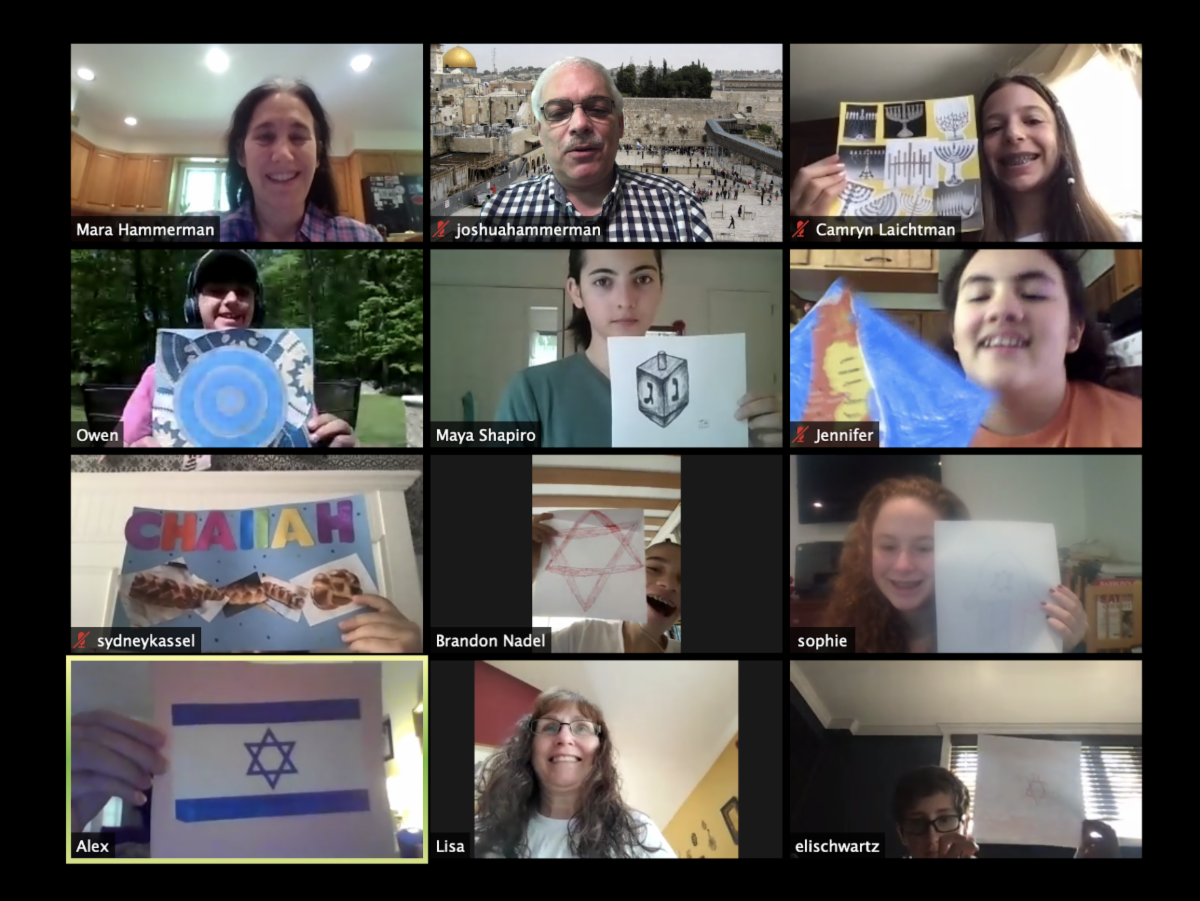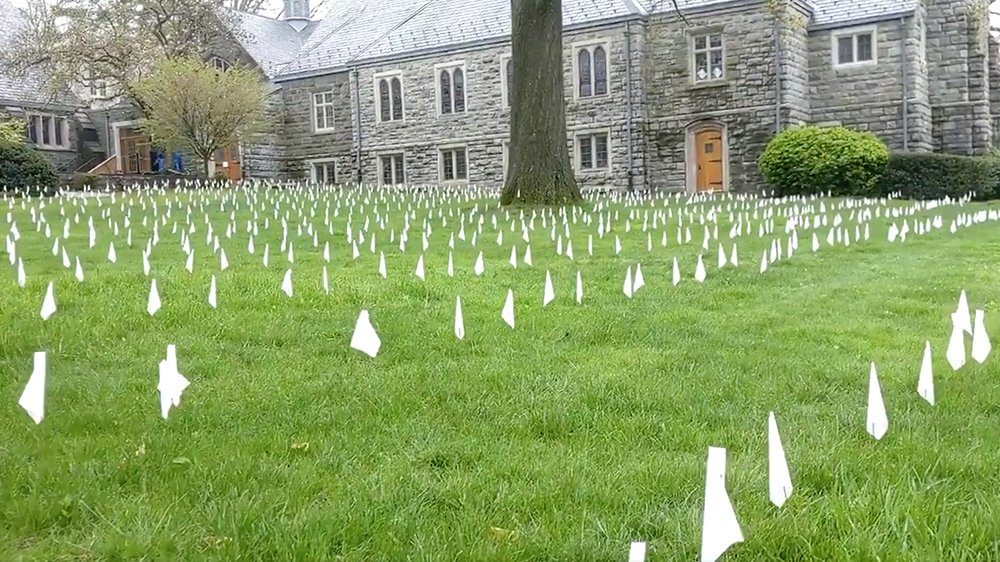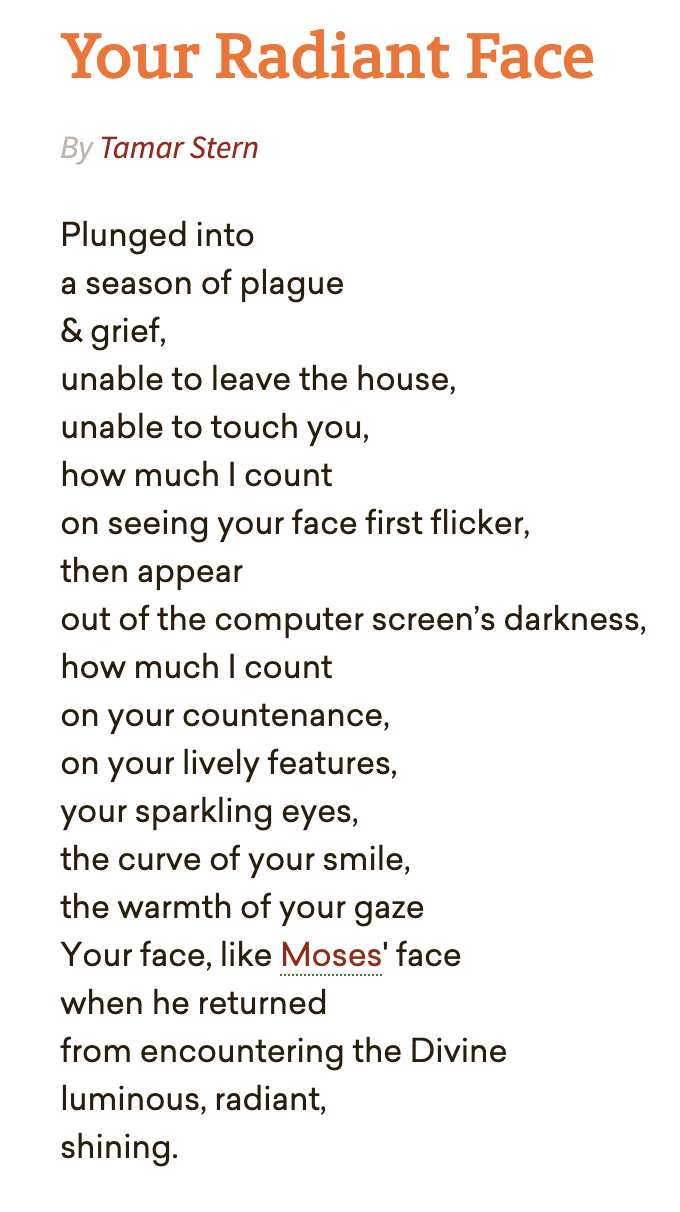From the Rabbi's Bunker
Boy, did this school year ever Zoom by!
Photos from the last day of a most unusual Hebrew School year...





See our entire winter - spring album at https://photos.app.goo.gl/5EMzq6yv7TNDuwKV7
Greetings from the Bunker (and Beyond)!

This past Shabbat I crept carefully out of the bunker and found my way back into the sanctuary on Shabbat - alone - to conduct a Zoom Shabbat service. I'm relieved to note that I did not see my shadow.
When I reached the bima, I needed to roll the Torah all the way from the middle of Exodus to the end of Leviticus, as we hadn't used it since mid-March. That allowed me to reset my inner spiritual clock to Torah Time, and it felt good. Reclaiming our sanctuary was important for those who attended the service (and the virtual attendance was double our usual Shabbat crowd). We all needed to feel like we were back, knowing that there is still great danger. Click here (and scroll down) to see more photos from Shabbat morning and also our lovely Zoom Kabbalat Shabbat Friday night with Beth Styles. You can watch a recording of that service here.
Book Talk

Join me Wed. morning at 10 AM for a Book Talk on my new book, "Embracing Auschwitz: Forging a Vibrant, Life-Affirming Judaism that Takes the Holocaust Seriously." Sponsored by the Jewish Historical Society. You can purchase the book here. Let me know once you've ordered a hard copy and I'll be happy to sign it remotely!
And to avoid printer's delays, here is a link for the Kindle e-book.
Click https://zoom.us/j/83779905601 to participate in the talk.
Password 679136. Click here to see the discussion guide.

------
Rapture or Rupture?
Poll: US believers see message of change from God in virus (Times of Israel). More than 60% of those who believe in God feel coronavirus is a sign telling humanity to change; 55% feel at least somewhat that God will protect them from being infected. What do you think? Is God trying to tell us something?
We're all trying to find deeper meaning in what has been happening, in part because we all have too much time on our hands - and in part because what's happening is truly extraordinary and its own way, unprecedented.
Many Christian fundamentalists are looking at these quasi-apocalyptic events for signs of what they call the Rapture, defined as "an end-time event when all Christian believers who are alive, along with resurrected believers, will rise "in the clouds, to meet the Lord in the air." The intensification of this fervor has even caused tension between the evangelicals their erstwhile allies, right wing Jews in Israel, who are not appreciating the introduction of those views to the Israeli airwaves, in the form of a new cable channel, God TV. It's become a big deal.
See this Times of Israel article on the tension: Trouble in paradise: 'GOD TV' spat exposes tensions between Israel, evangelicals. You see, the channel, known as "Shelanu," is broadcasting in Hebrew even though most Christians in the Holy Land speak Arabic. Hmm... And the CEO remarked in a video message, "God has supernaturally opened the door for us to take the Gospel of Jesus into the homes and lives and hearts of his Jewish people."
For many years, we've been assured that the unparalleled support of evangelicals for Israel is not tied to a belief that Jews would be assembled in Israel and compelled to convert when the Rapture comes. Now, apparently, the fervor for end times has unmasked the true intentions of at least one religious media CEO.
Meanwhile, 60 Minutes was must-see TV on Sunday. For our purposes, the most interesting segment was the third one: What will be the new normals after the coronavirus pandemic? Here are two particularly compelling passages:
The real reckoning of our age, maybe of our lifetime, is not whether we will prevail over the virus. It's whether our respect for science, and our collective will-so muscular during the crisis-will prevail when we reboot and rebuild.
Let's start with a thought exercise: It's New Year's Eve heading into 2020, a number, ironically, associated with perfect vision and clarity. What's your response that night upon being told that soon there will be no live sports or concerts or Broadway shows? That Grand Central Station at rush hour will look like this? That toilet paper might be more valuable than crude oil? That by spring, there will be food lines on the streets of New York and more than 300,000 people worldwide will have died tragically.
Looking back, Mother Earth was starting to clear her throat and make herself heard: Australian bush fires were ravaging the continent. Earth had registered its highest temperatures since records began. Icebergs and glaciers melted, popsicles in the sun; there were floods and droughts; and swarms of locusts descending on Africa....
...Arundhati Roy: Right now it feels as though we have no present, you know? We have a past. And we have a future. And right now we're in some sort of transit lounge. And there isn't any connection between the past and the future. We should not be trying to stitch them together without thinking about that rupture, you know? And that rupture is not just one of production and consumption and all our-- you know, it's-- I think the most profound thing is the rupture of the idea of touch, you know, the idea of proximity. All these things will become so laden with risk and fear for a long, long time.
If microbes have the ability to create a rupture in the lives of billions, we humans have our own powers and evolutionary advantages. Our intelligence, empathy, and our ability to cooperate. It's hard to conceive of another time in human history when, worldwide, the best minds of our generation were all fixated on solving the same riddle, scribbling on the same blackboard, sharing data and sharing screens.
So, rupture or rapture? How we answer that question will have much to do with the world we forge coming out of this - and, in fact, whether we will have the scientific wherewithal to come out of this at all.
---------
Conservative Judaism Adapts
You may have seen the articles last week indicating, "Conservative Rabbis Rule on Live Streaming." Indeed that happened, and for those who want the first draft of history, here is the complete teshuvah (responsum): Rabbinical Assembly Responsum on Shabbat/Festival Live Streaming and Zoom Meetings During the Pandemic.
The Forward asked a legitimate question: Now that the Conservative Movement has Livestream, is there any difference with Reform? And Reform is dealing with its own issues right now too, so why not merge? Well, yes there are still differences, though for the layperson it's more a matter of form (style of prayer, level of Hebrew) than content. But what is so true is that the pandemic has reshuffled the deck dramatically, and we have no idea what the coming years will bring for congregations, be they Reform, Conservative, Orthodox or for that matter Presbyterian. I tend to see the disruptive glass as half full, as does the preeminent scholar of American Judaism, Jonathan Sarna Enough doom and gloom: History shows American Judaism is much more resilient than you think.
But meanwhile, we all are groping for answers as to when we can pray together in person. Christianity Today asks this question: How do we reopen? And they present some ideas: When Your Church Reopens, Here's How to Meet Safely.
---------
| Check out TBE's own DAVID SHEPARD's New YouTube Channel, featuring biting sports commentary! Way to go, David! |
--------
Hasidic Jews, Hit Hard by the Outbreak, Flock to Donate Plasma (NYT) "From a moral and religious perspective, we have every obligation to do whatever we can," said Mr. Weinstock. "If we'll find out later it saved 50 lives or 100 lives or 20 lives, whatever the case is, if it's 20 lives, it's worth every effort, every minute of it."

Pastor Patrick Collins has placed a white flag on the front lawn of the First Congregational Church in Old Greenwich, Connecticut, in honor of every COVID-19 victim in the state.
This article of mine appeared today and is being syndicated by the Religion News Service. In expressing the Jewish attitude toward the value if human life, goes nicely with the one noted above, about the donations of plasma.
Recently, at one of his daily news conferences, Gov. Andrew Cuomo addressed the question that has haunted so many of us lately: How much is a human life worth?
"If it's public health versus the economy," he said, "the only choice is public health. You cannot put a value on human life. You do the right thing."
While he was speaking, the PowerPoint display behind him flashed the answer to his query like a vintage MasterCard commercial:
Priceless.
Jewish tradition agrees with that wholeheartedly. While at times lives must be sacrificed for higher causes, such as a defensive war for national survival, the Talmudic sages would never have countenanced the reckless disregard for life that we are seeing now from those seeking to open their economies without providing sufficient safeguards to protect the most vulnerable.
We desperately need a functioning economy, but that is precisely why we need to have massive testing, tracing and a 14-day "downward curve" to enable a sensible opening while preventing needless deaths.
With the current situation becoming increasingly painful, both medically and economically, governments are coming up with their own calculations as to what a human life is worth as a means of helping them make excruciating policy decisions. A recent article in The New York Times states that the U.S. Consumer Product Safety Commission uses a figure of $8.7 million, the Environmental Protection Agency uses $7.4 million, and the Department of Transportation (which includes the Federal Aviation Administration) uses $9.6 million.
Such calculations may be practical and in some manner necessary, but quantifying the value of a human life carries great risk and should be done with caution.
As the world commemorates this month the 75th anniversary of the end of the Second World War, let's recall that the Nazis, who loved to put numbers on everything from death camp ledgers to human arms, put an actual value on a person's life. In stark contrast, the idea that each human life is of infinite worth has been at the core of Judaism - and other traditions - for many centuries.
In his essay, "Clouds of Smoke, Pillars of Fire," Rabbi Irving (Yitz) Greenberg, one of the leading theologians of the post-Holocaust era, asserts that in contrast to the ethos that has defined Jewish values for centuries, the Nazis' behavior proclaimed the fact that they thought that a Jewish life was not worth one cent.
This is what he means. When the Nazis struggled mightily to finish their genocidal mission in 1944 by wiping out nearly a million Hungarian Jews, they began to run short of Zyklon B, the lethal chemical of choice for their gas chambers. In addition, the Nazis deemed the costs excessive. So, to keep up with their diabolical quotas, they cut the gas in half, from 12 boxes to six per gassing, which in turn tripled the amount of time it took for the victims to die, increasing their suffering exponentially.
Even worse, according to testimony of survivors, some children were thrown while still alive straight into the furnaces. All to stretch their Deutschmarks and save gas. The result was a bottom line of less than one cent per Jewish corpse.
Greenberg did the math (and if you need proof, the original invoice for Zyklon B can be found in the Yad Vashem archives):
How much did it cost to kill a person? The Nazi killing machine was orderly and kept records. The bills for Zyklon B came to 195 kilograms for 975 marks, which equals 5 marks per kilogram. Approximately 5.5 kilograms were used on every chamber load, about 1500 people. This meant 27.5 marks per 1500 people. With the mark equal to $0.25, this yields $6.75 per 1500 people or 45 hundredths of a cent per person. In the summer of 1944, a Jewish child's life was not worth the 2/5 of a cent it would have cost to put it to death rather than burn it alive.
Because life has infinite value, the greatest mitzvah (Jewish religious obligation) is to save a single life - so great that it supersedes the observance of nearly every other commandment, including Shabbat and the Yom Kippur fast. This understanding led to an extraordinary gesture last week, when 35 rabbis from Missouri put their names to a petition stating that voting by mail during a pandemic is a religious imperative. When lives are legitimately at risk, they are saying, the Torah obligates us to stay home.
Political theorist Judith Butler, whose recent work has focused on philosophies of vulnerability and mourning, claims that "learning to mourn mass death means marking the loss of someone whose name you do not know, whose language you may not speak, who lives at an unbridgeable distance from where you live."
We have to learn how to mourn each single victim, so that instinctively, the soon-to-be hundred thousandth American to die of the coronavirus will be perceived as a unique, immeasurable universe, and not as a number.
A pastor in Greenwich, Connecticut, is memorializing each victim in his state by planting a flag on the front lawn of the church. We need to do that, too. We need our own Paper Clips Project - a memorial like the one a small rural school in Tennessee came up with, collecting six million paper clips to demonstrate the magnitude of the tragedy that was the Holocaust. We could stack our clips next to one of those omnipresent Johns Hopkins Covid-19 maps.
These dead, these victims, helpless and vulnerable, the weakest of our society, whose lives have been cut short so painfully and in many cases so needlessly, must never be allowed to amalgamate into a nameless, faceless mass.
At the same time, the living, too - the unemployed, displaced and otherwise upended - need to be seen as individual sufferers rather than trends. At a time when our senses are overwhelmed by unimaginable numbers, no human being should become a statistic.
As the Holocaust begins to recede from immediate memory with the passing of 75 years, one incontrovertible fact shines like a beacon from out of the deepest darkness of the 20th century and stands as a sharp reminder to all of us as we face this overwhelming, numbing pandemic that will define the 21st:
We must treasure each precious, priceless human life.
(Rabbi Joshua Hammerman is the spiritual leader of Temple Beth-El in Stamford, Connecticut, and the author, most recently, of "Embracing Auschwitz: Forging a Vibrant, Life-Affirming Judaism that Takes the Holocaust Seriously." The views expressed in this commentary do not necessarily reflect those of Religion News Service.)
Healing Prayers
On Sunday at our healing service, I used several selections from the excellent site ritualwell.org. Here are some examples...







Shalom from the Bunker,
Rabbi Joshua Hammerman

No comments:
Post a Comment